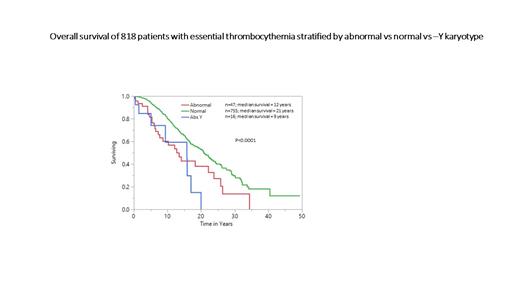Abstract

Background
Cytogenetic abnormalities at diagnosis are relatively uncommon in essential thrombocythemia (ET). In the current study of 818 consecutive patients with ET who were fully annotated for karyotype, we describe the spectrum and prevalence of cytogenetic abnormalities at diagnosis, followed by a comprehensive assessment of phenotypic and molecular correlates and prognostic relevance.
Methods
The study cohort consisted of 818 consecutive patients with ET that were diagnosed according to the World health Organization 2016 criteria and underwent evaluation between 1967-2021. In order to minimize the inadvertent inclusion of patients with masked polycythemia vera, JAK2 mutated cases with hemoglobin (Hb) level >16 g/dL in women and 16.5 g/dL in men were excluded; similarly, cases with anemia defined by sex adjusted Hb level of <11 g/dL in women and <12.5 g/dL in men were also excluded, in order to avoid inadvertent inclusion of patients with prefibrotic myelofibrosis. Cytogenetic studies were performed either at or within one year of diagnosis and reported according to the International System for Human Cytogenetic Nomenclature. Disease status and survival information was updated in May 2021. JMP Pro 16.0.0 software package, SAS Institute, Cary, NC was utilized for all analyses.
Results
Prevalence and spectrum of cytogenetic abnormalities
Karyotype was normal in 755 patients (92%), showed loss of Y chromosome (-Y) in 16 (2%), and showed abnormalities other than -Y in 47 (5.7%); most common abnormalities included del(20q) (n=10, 21%), trisomy 9 (n=8, 17%), trisomy 8 (n=2, 4%), del(5q) (n=2, 4%), and del(3p) (n=2, 4%). Other sole cytogenetic abnormalities were identified in 18 (38%) patients.
Phenotypic and molecular correlates
Abnormal karyotype, other than -Y, in comparison with normal karyotype was associated with older age (median age; 63 vs 58 years, p=0.02), lower hemoglobin level (p=0.003), and a higher incidence of arterial thrombosis prior to/at diagnosis (25% vs 13%; p=0.03). 603 patients were annotated for driver mutations; abnormal/normal/-Y frequencies were 78%/60%/71% for JAK2, 22%/26%/14% CALR, 0%/3%/0% MPL and 0%/10% /14% triple negative (p=0.31). NGS information was available in 226 patients and showed absence of ASXL1 mutation in all patients with abnormal karyotype vs 8/211 (4%) with normal karyotype vs 2/4 (50%) with -Y (p<0.0001).
Disease transformation and overall-survival.
At a median follow-up of 9.6 years (range; 0.01-49.4 years), a total of 96 patients (12%) underwent fibrotic transformation: 6 (13%) with abnormal karyotype, 89 (12%) with normal karyotype and 1 (6%) with -Y (p=0.77). Leukemic transformation rates were also similar with respective frequencies of 4%, 3% and 0% (p=0.71). Abnormal karyotype and -Y were associated with inferior survival with median of 12 years (range; 0.1-34) and 9 years (range; 0.01- 19.9), respectively, compared to 21 years (range; 0.01-49.4) for normal karyotype (p<0.0001) (Figure). In univariate analysis, risk factors for overall survival included abnormal karyotype (p=0.001), - Y (p=0.004), age >60 years (p<0.0001), leukocytosis >11 x10 9/L (p<0.0001), male gender (p=0.0003), and history of thrombosis (p=0.001). During multivariable analysis, abnormal karyotype other than -Y (p=0.003), age >60 years (p<0.0001), leukocytosis >11 x10 9/L (p=0.001), and male gender (p=0.01) remained significant. Additional analysis suggested individual prognostic impact for del(20q) (p=0.04) and also for trisomy 9 (p=0.09) and other abnormalities (p=0.07), with borderline significance.
Conclusion
The current study confirms the association of abnormal karyotype in ET with older age, lower hemoglobin level, and history of arterial thrombosis, and its mutual exclusivity with ASXL1 mutations. Our observation regarding the independent adverse impact of abnormal karyotype other than -Y, on overall survival, in the absence of association with fibrotic or leukemic transformation, requires clarification from additional studies, which should also investigate the effect of specific abnormalities.
Szuber: Novartis: Honoraria.
Author notes
 This icon denotes a clinically relevant abstract
This icon denotes a clinically relevant abstract


This feature is available to Subscribers Only
Sign In or Create an Account Close Modal